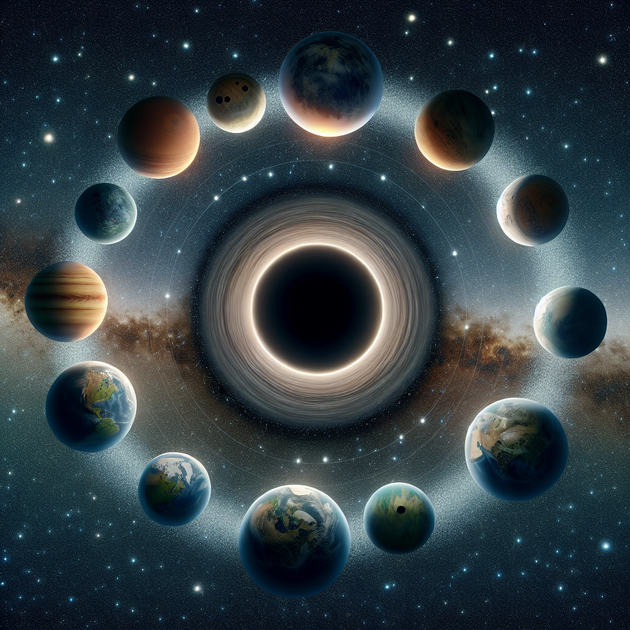Have you ever wondered what would happen if our Sun was replaced with a black hole at the center of the solar system? And not just that—imagine all eight planets circling it together on one giant shared orbit, like beads on a necklace. Could any kind of Earth-like life survive in such a strange setup?
Let’s dive into this galactic thought experiment and see where science takes us.
## What Happens When You Put a Black Hole at the Heart of the Solar System?
First things first—if you swapped out our Sun for a black hole with exactly the same mass as the Sun, things wouldn’t look as dramatic as you might think (at least at first). The gravity pulling on Earth and its neighboring planets would stay exactly the same. So Mercury to Neptune would keep spinning around as usual.
But there’s one very big difference: no sunlight. Black holes don’t emit light or heat like stars do (unless they’re actively gobbling up matter). Without that warmth and energy, temperatures on every planet would plummet fast. Earth’s surface would freeze solid within weeks or months.
So right off the bat, carbon-based life as we know it—plants, animals, bacteria—wouldn’t stand much of a chance without some other source of energy.
## Can Planets Share the Same Orbit Around a Black Hole?
Here’s where things get even wilder. Imagine all eight planets traveling around this central black hole along *the exact same path*, spaced out evenly like beads on an invisible wire.
Is that even possible? In physics terms, that’s called “co-orbital” or “Trojan” planets. It’s rare but not impossible! Jupiter has Trojan asteroids sharing its orbit at stable points called Lagrange points. But getting eight big planets to share one orbit in perfect harmony is extremely unlikely—the gravitational tugs between them would eventually make their paths unstable.
Here’s why co-orbital planets are so tricky:
– Gravitational pulls make it hard for large objects to stay in sync.
– Even tiny bumps can build up over time and throw everything off.
– The more massive (and close together) the planets are, the harder it is to keep them from colliding or scattering.
– No real-life examples of eight co-orbital planets have ever been found.
So while it makes for cool sci-fi art or mental images, nature doesn’t seem to favor multi-planet garlands around stars—or black holes!
## Could Life Survive Near a Black Hole?
Let’s get back to life—the real showstopper in your question. Is it possible for carbon-based life to exist in such an extreme solar system with a black hole center?
The short answer is: not really—not unless there’s another energy source besides sunlight. With no heat or light coming from the central object, any habitable planet would need:
– A way to capture energy (like tidal heating from being stretched by gravity)
– An internal heat source (like radioactive decay deep underground)
– Maybe even artificial habitats powered by fusion or some other tech
But for surface-dwelling life like we see on Earth—plants needing sunlight and stable temperatures—it’s next to impossible without some kind of star providing constant energy.
That said, microbes living deep underground near hydrothermal vents might hang on for a while using leftover geothermal energy—but they wouldn’t last forever.
## Is Anyone Actually Searching for These Wild Systems?
Astronomers have found exotic worlds around all kinds of stars—red dwarfs, giants—even dead stars like white dwarfs and neutron stars. Some researchers are curious about what happens around small or quiet black holes too.
But spotting actual “solar systems” with multiple big planets circling quietly around isolated black holes is really tough:
– Black holes don’t shine—so they’re almost invisible except when feeding.
– Planets are tiny specks compared to their host—they don’t give off enough light to spot easily.
– Most searches focus on looking for wobbles or blips caused by stars—not invisible objects like quiet black holes.
There *is* some research into finding “rogue” planets kicked out of their systems (possibly by interactions with black holes), but so far no evidence of big planetary families orbiting silent black holes has turned up.
### Picture This Sky…
Just imagine standing on one of these hypothetical worlds—no sunrise, just pitch-black sky dotted with distant stars and maybe faint glimmers from nearby gas swirling into your central black hole. The other seven sister-planets might be visible as bright points moving along your shared orbit—a cosmic necklace lit only by starlight!
I remember reading about this idea in an old sci-fi novel as a kid—the image stuck with me for years! Sometimes thinking about these wild possibilities is half the fun of loving space.
So what do you think? If you could visit such an unusual solar system with a black hole at its heart—even just once—would you go?
—

Leave a Reply